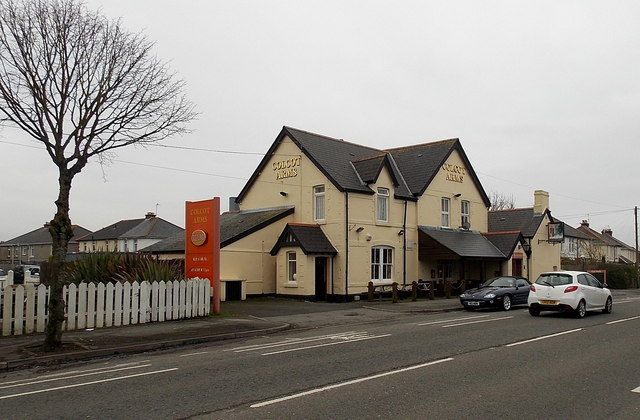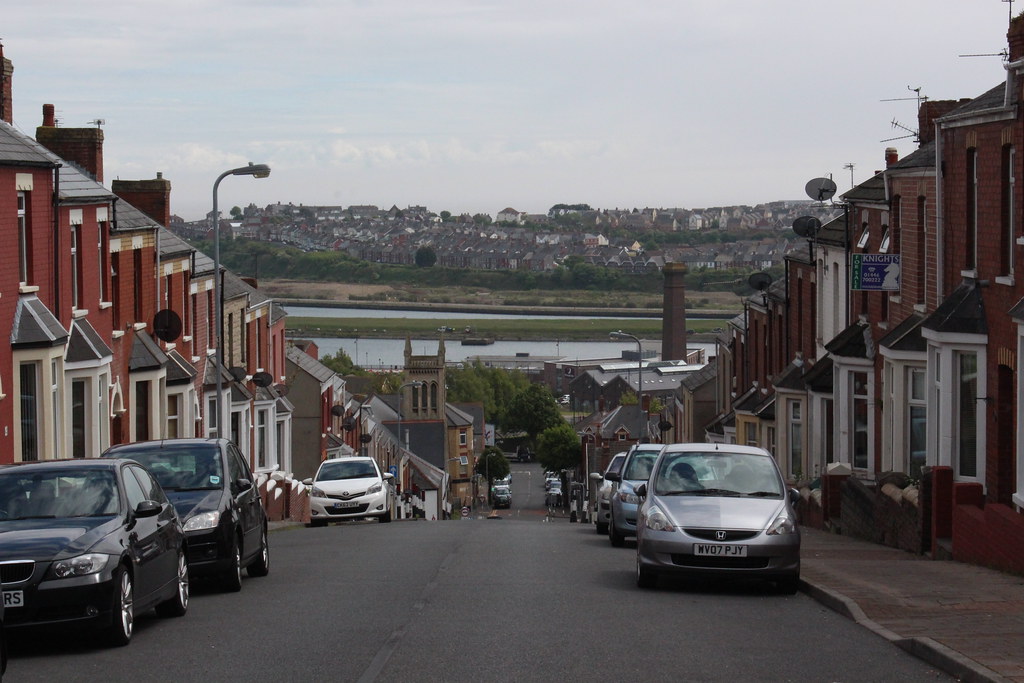On the 4th September 2020 I set off from home and after just over 3 and a half hours drive, my wife and I arrive at Barry Island in the Vale of Glamorgan South Wales.
As we drive in we pass the Colcott Arms,the Colcot Arms is set in Billericay – it's the local pub in which Smithy hosts his pub quiz.

First stop was to drive to 47 Trinity Road the location of Stacey's House from the BBC show 'Gavin and Stacey' where she lives with her Mum Gwen West.
Across the road at 48 is Uncle Bryns House, been nice to knock and ask what happened on that camping trip!
View down Trinity Street to Barry Island.
We drive down to Barry Island and paid the £6 for a days parking. Shame only options was 1 hour or day!
We are on the seafront of Barry Island or ‘Barrybados’, as it’s affectionately been nicknamed by the locals. In the 20th century it was home to a thriving Butlins holiday resort and pleasure park filled with amusement rides. After a period of decline, Barry Island has been redeveloped with a new seafront and investment into the pleasure park.
The holiday camp was used to film scenes in the "Shangri-La" holiday camp in the Doctor Who serial Delta and the Bannermen. The island was also a location for Doctor Who in the 2005 series episodes "The Empty Child" and "The Doctor Dances", standing in for a bomb site in 1941 London and the 2014 series episode "Flatline".
Tourism has had a further boost in recent years thanks to the hit BBC television series Gavin and Stacey, set in the nearby town of Barry with the beach front frequently popping up in episodes. Over the road from the beach are a variety of gift shops selling souvenirs based around the hit series.
Stacey works at Marco's cafe, which is a real cafe on the front; across the road is where Nessa works at the arcades. The gang plonk themselves on the beach right in front of the Western Shelter by Boofy's and O'Shea's chippies (yum) and it's the place where Gav meets Stacey off the bus after their first meeting in London.
 |
| Marco' Cafe, where Stacey works. |
The recently refurbished seafront now offers a sweeping promenade along the entire length of Whitmore Bay beach, against a backdrop of enticing cafés and restaurants, beach wheelchairs available to loan, vibrant beach huts and lots to amuse the kids with a climbing wall, mist feature, adventure golf and beautiful landscaped gardens. Or for the more adventurous, Barry Island Pleasure Park offers thrilling rides.
We take a walk along the sandy beach that featured a few times in the BBC show.
The peninsula was an island until the 1880s when it was linked to the mainland as the town of Barry expanded. This was partly due to the opening of Barry Docks by the Barry Railway Company. Established by David Davies, the docks now link up the gap which used to isolate Barry Island.
The area around Barry Island shows extensive evidence of human occupation. Mesolithic or Middle Stone Age microlith flint tools have been found at Friars Point on Barry Island and near Wenvoe, and Neolithic or New Stone Age polished stone axe-heads were discovered in St. Andrews Major. As the area was heavily wooded and movement would have been restricted, it is likely that people also came to what was to become Wales by boat, apparently from the Iberian Peninsula. They cleared the forests to establish pasture and to cultivate the land.
These neolithic colonists, who integrated with the indigenous people, gradually changed from being hunter-gatherers to settled farmers. They built the long barrows at St Lythans and Tinkinswood, which date to around 6,000 BP, only 3 miles (4.8 km) and 4 miles (6.4 km) to the north of Barry Island, respectively.
In common with the people living all over Great Britain, over the following centuries the local population assimilated immigrants and exchanged ideas of the Bronze Age and Iron Age Celtic cultures. Together with much of South Wales, Barry Island was settled by a Celtic British tribe called the Silures. There have been five Bronze Age burial mounds, or cairns, recorded on Friars Point.
Although the Roman occupation left no physical impression on Barry Island, there were Romano-British settlements nearby in Barry and Llandough. These people embraced the Roman religion of Christianity and dedicated a chapel to St Baruc, a disciple of St Cadoc. Having forgotten to bring St Cadoc's reading matter with him, on a journey from the island of Flat Holm, St Baruc was sent back and he drowned in the Bristol Channel on the return journey. He was buried on Barry Island and the ruins of the chapel that was dedicated to him can still be seen in Friars Road. His feast day is on 27 September.
The Vikings launched raids in the area and Barry Island was known to be a raider base in 1087.
We walk from Whitmore bay and onto Little Island and up to the top.
We walk back to the seafront and visit Island Leisure Amusement Arcade, Western Shelter. This is where Nessa worked in the change booth.
We walked back towards the car and stopped for breakfast in Romys cafe. This was the worst breakfast we've had in our lives! Cooking bacon bit, disgusting other bits and a old mushroom doing a backstroke in the oil! Avoid avoid, wish we'd gone elsewhere, was ill later that night!
We leave Barry and drive to our campsite Brodawel Campsite in Nottage, just outside Porthcawl.
Lovely site, just make sure you've got a pitch away from the toilet block, that had a waft of sewage in the air.
So after setting up we drove a short way up the road to Porthcawl and found a free spot to park on West Drive and we walked back into town.
Porthcawl is Historically part of Glamorgan and situated on a low limestone headland on the South Wales coast, overlooking the Bristol Channel, Porthcawl developed as a coal port during the 19th century, but its trade was soon taken over by more rapidly developing ports such as Barry. Northwest of the town, in the dunes known as Kenfig Burrows, are hidden the last remnants of the town and Kenfig Castle, which were overwhelmed by sand about 1400.
Porth is a common Welsh element, here it means harbour, but the second element is disputed. Local tradition states that cawl is a corruption of Gaul, and that the area was an ancient landing point for Gaulish and Breton, or later Frankish and Norman knights.A modern, if unlikely, interpretation is Cawl harbour.
Porthcawl, like many British resorts, has suffered a decline in its holiday trade over recent years, especially since most of the South Wales Valleys coal pits closed. A major feature of the summer was the miners' fortnight, when large numbers of miners took their annual break.
Harbour Quarter
Porthcawl Lifeboat Station, purpose-built in 1995, is situated near the harbour. The station operates an inshore B class Atlantic 85 lifeboat and a D class IB1. 'Cosy Corner' is a park area, which over the years has housed a theatre, cinema, roller skating rink and ballroom. The Jennings Building, built in 1832, is a grade II listed building and Wales' oldest maritime warehouse, and is currently vacant. The building has been identified as a potentially important facility as part of the Porthcawl Regeneration Strategy.
At the end of Porthcawl Pier stands a white lighthouse built in 1860. The lighthouse is currently in use as a navigational aid. Porthcawl Lighthouse was the last coal and gas-powered lighthouse in the UK. It switched to being powered by North Sea gas in 1974, before becoming powered by electricity in 1997. The pier and surrounding area are popular spots for sea fishing.
The historic ships the PS Waverley, the last seagoing paddle steamer in the world, and the MV Balmoral sail from this area during the summer months.
Tourist attractions in the area include sandy beaches, a grand pavilion, a funfair named Coney Beach (modelled on Coney Island in New York), a museum and three golf courses.
We head back to the site and then head into Nottage, where I had a pint in the Farmers Arms and a bowl of chips.
 |
A good day in not so good weather, but a great day planned for the next day walking the Four Waterfalls walk!



































